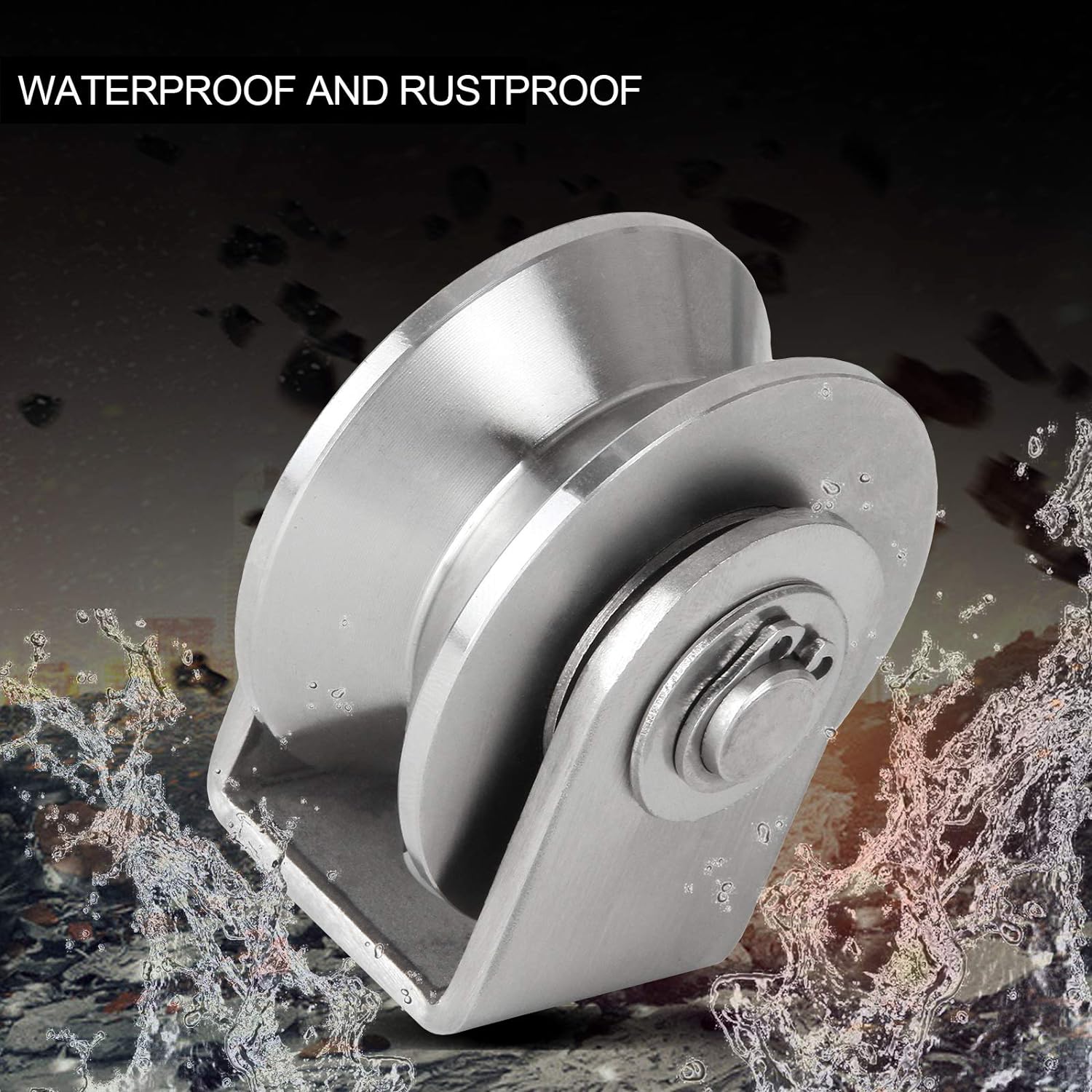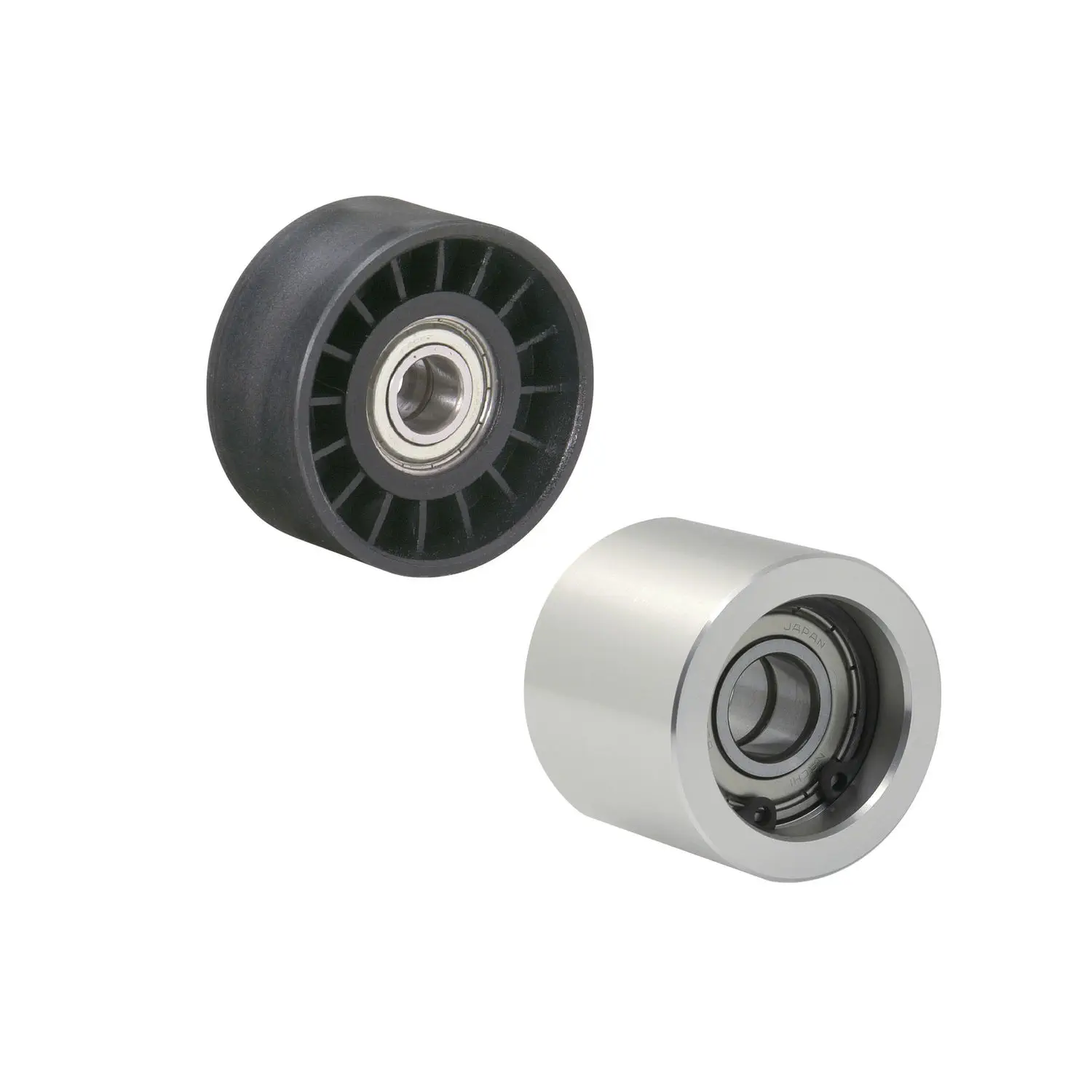Product Description
PULLEY BEARING,SLIDING DOOR ROLLER BEARING
1.Material: Chrome steel , High carbon steel, Low carbon steel ,Stainless steel material .
2.Precision Rating: P0 P1 P2 P3 P6 P5 P4
3.Vibration: V1,V2,V3,V4
4.Clearance: C0 C2 C3 C4 C5
5.Noise Level: Z, Z1, Z2, Z3, Z4
6.Quality: ABEC1, 3, 5, 7,9
7.Lubrication: oil, grease
8.Application :This type of the roller with bearings are widely used in the different of door, window . Suitable for commercial building, office building , hotel window, gate wheel bearing, sliding door, window etc.
9.Surface treatment : plating or polishing .
10.color: red ,black, orange white ,green or for customer require.
11.shape: u / v sliding plastic bearings roller , also can according to customer drawing made.
Product Description
Company Profile
ZheJiang CHINAMFG Bearing Co., Ltd. is affiliated to ZheJiang Kaidi Bearing Group – a specialized manufacturer of kinds of bearings for about 20 years.
Our company is specialized in producing Deep Groove Ball Bearings, Tapered Roller Bearings, Spherical Roller Bearings and Special Bearings in accordance with Customers’ designs.Our bearings has been widely applied into agricultural equipments, home appliances, power equipments, machine tools, automotives and engineering machinery, etc.
Our Products
ZheJiang CHINAMFG Bearing Co., Ltd. is a specialized manufacturer of ball bearings for about 20 years. Our main products include:
1, Miniature Bearings: like 608, 609, 625, 626, 693, 695, etc;
2, Deep Groove Ball Bearings: like 6000, 6200, 6300, 6800, 6900, 16000 Series;
3,Non-Standard Bearings: U grooved bearings, V grooved bearings, double grooved bearings, bearing rollers with or without plastic injection. 4,Pillow Block Bearing: UCP/ UCF/ UCFL;
5,Tapered Roller Bearings
6,Linear Motion Bearings
Processing Process
we have manufacture bearing more than 20 years, and can produce different style of bearings. Our factory starts production from raw materials. We have a 20-person R&D team and launch a new product every 5 days. We have more than 600 people to produce bearing team, we produce products, the price is the most competitive in China.
Packaging & Shipping
Our Activities
FAQ
|
1.Q:Do you know the Detail Size for the Bearing ? 2.Q: This Size of Bearing is common parts? 3.Q:Are you a factory or a Trade Company for Bearing ? 4.Q:How many the MOQ of the Bearing? 5.Q:Could you supply free sample of bearing for our test? 6.Q:Could you accept OEM and customize? 7.Q:Do you have stocks? |
Contact Us
Jane
ZheJiang CHINAMFG Bearing Co., Ltd.
/* January 22, 2571 19:08:37 */!function(){function s(e,r){var a,o={};try{e&&e.split(“,”).forEach(function(e,t){e&&(a=e.match(/(.*?):(.*)$/))&&1
| Contact Angle: | 15° |
|---|---|
| Aligning: | Non-Aligning Bearing |
| Separated: | Unseparated |
| Rows Number: | Single |
| Load Direction: | Thrust Bearing |
| Material: | Bearing Steel |
| Samples: |
US$ 0.05/Set
1 Set(Min.Order) | |
|---|
| Customization: |
Available
| Customized Request |
|---|

How do roller pulleys enhance the reliability and performance of conveyor systems?
Roller pulleys play a crucial role in enhancing the reliability and performance of conveyor systems. Here are several ways in which they contribute to the overall efficiency and effectiveness of these systems:
- Smooth Material Handling: Roller pulleys provide a smooth and controlled surface for materials to move along the conveyor system. The rotating rollers minimize friction and resistance, allowing for efficient and consistent material flow. This smooth handling reduces the risk of jams, bottlenecks, and product damage, resulting in improved operational reliability.
- Load Distribution: Roller pulleys distribute the weight of the conveyed materials across multiple rollers, evenly distributing the load. This load distribution prevents excessive stress on individual rollers, bearings, and other conveyor components. By distributing the load, roller pulleys help maintain the integrity of the conveyor system, minimize wear and tear, and extend the overall lifespan of the equipment.
- Reduced Power Requirements: The low rolling resistance provided by roller pulleys reduces the power requirements of the conveyor system. With less energy needed to move materials along the conveyor, the system operates more efficiently, resulting in lower energy consumption and reduced operating costs.
- Flexibility and Adaptability: Roller pulleys offer flexibility and adaptability in conveyor system design. They can be configured to accommodate various layouts, including straight sections, curves, and inclines. Roller pulleys with specialized features, such as tapered rollers or grooved rollers, can be utilized to handle specific material handling requirements. This adaptability allows for the efficient customization of conveyor systems to suit different applications and operational needs.
- Easy Maintenance: Roller pulleys are designed for easy maintenance and replacement. They are typically accessible and can be quickly replaced when necessary. Routine maintenance tasks, such as lubrication or cleaning, can be performed efficiently, minimizing downtime and maximizing the availability of the conveyor system.
- Compatibility with Automation: Roller pulleys are compatible with various automation technologies, such as robotics and automated guided vehicles (AGVs). They can seamlessly integrate with these systems, enabling the automation of material handling processes. Roller pulleys ensure precise movement and alignment, allowing for smooth interaction between the conveyor system and automated equipment.
- Scalability: Roller pulleys facilitate the scalability of conveyor systems. Additional roller pulleys can be easily incorporated to extend the length of the conveyor or accommodate increased material flow. This scalability allows for the efficient expansion or modification of conveyor systems as operational requirements evolve.
By providing smooth material handling, load distribution, reduced power requirements, flexibility, easy maintenance, compatibility with automation, and scalability, roller pulleys significantly enhance the reliability and performance of conveyor systems. They optimize material flow, minimize downtime, and contribute to the overall productivity of logistics and manufacturing operations.

What is the significance of proper roller spacing and alignment in roller pulley systems?
Proper roller spacing and alignment in roller pulley systems are of significant importance for the smooth and efficient operation of conveyor systems. Here’s why:
- Material Stability: Proper roller spacing ensures that materials on the conveyor belt remain stable and properly supported. When the rollers are appropriately spaced, the weight of the materials is evenly distributed, minimizing the risk of material spillage or uneven loading. This improves the overall stability of the conveyed items, reducing the chances of jams, blockages, or damage during transportation.
- Belt Support: Correct roller spacing provides adequate support to the conveyor belt. Insufficient roller spacing can result in excessive sagging or stretching of the belt, leading to increased friction, wear, and potential belt misalignment. On the other hand, excessive roller spacing can cause the belt to become taut, leading to increased tension and potential damage. Proper roller spacing ensures optimal belt support, contributing to its longevity and reliable performance.
- Prevention of Material Buildup: Incorrect roller spacing can result in material buildup between the rollers or along the edges of the belt. This buildup can cause material accumulation, belt slippage, or even belt damage. By maintaining proper roller spacing, the risk of material buildup is minimized, ensuring smooth material flow and preventing operational disruptions.
- Belt Tracking: Proper roller alignment plays a crucial role in belt tracking. Misaligned rollers can cause the belt to veer off-course, leading to belt mistracking, potential damage, and increased wear. Well-aligned rollers promote consistent belt tracking, ensuring that the belt stays centered and properly guided along the conveyor path.
- Reduced Friction and Wear: When roller pulleys are correctly aligned, the contact between the belt and the rollers is optimized, reducing friction and wear. Misaligned rollers can cause the belt to rub against the edges or surfaces of the pulleys, resulting in increased friction, heat generation, and accelerated belt wear. Proper roller alignment minimizes these issues, extending the lifespan of the belt and reducing maintenance requirements.
- System Efficiency: Proper roller spacing and alignment contribute to the overall efficiency of the conveyor system. When materials flow smoothly, without jams or interruptions caused by improper spacing or misaligned rollers, the system can operate at its designed capacity. This improves productivity, reduces downtime, and enhances the overall performance of the material handling process.
In summary, proper roller spacing and alignment are critical for maintaining material stability, providing adequate belt support, preventing material buildup, ensuring proper belt tracking, reducing friction and wear, and enhancing the efficiency of roller pulley systems. Regular inspection and adjustment of roller spacing and alignment are essential maintenance practices to optimize the performance and reliability of conveyor systems.

How does the design of rollers on a roller pulley impact its performance?
The design of rollers on a roller pulley plays a crucial role in determining its performance and effectiveness in conveyor systems. Various design factors can impact the performance of rollers. Here are some key aspects to consider:
- Roller Material: The choice of roller material affects factors such as durability, friction, and resistance to wear. Common materials used for rollers include steel, stainless steel, plastic, and rubber. Each material has its own advantages and suitability for specific applications.
- Roller Diameter: The diameter of the roller affects the contact area with the conveyor belt. Larger diameter rollers distribute the load over a larger surface area, reducing the pressure on the belt and minimizing the risk of belt damage. Smaller diameter rollers, on the other hand, may be suitable for applications with limited space or for conveying smaller materials.
- Roller Surface: The surface of the roller should be designed to reduce friction and promote smooth material movement. It should be smooth, free from sharp edges or protrusions that could damage the conveyor belt. Additionally, certain surface patterns or coatings can enhance grip and prevent material slippage.
- Roller Bearings: The type and quality of roller bearings are critical for smooth rotation and longevity of the roller pulley. High-quality bearings reduce friction, improve efficiency, and minimize maintenance requirements. Sealed or lubricated bearings can also enhance performance by protecting against contamination and reducing wear.
- Roller Configuration: Roller pulleys can feature various roller configurations, such as straight rollers, tapered rollers, or impact rollers. The choice of configuration depends on the specific application requirements, such as redirecting materials, reducing impact forces, or maintaining proper belt tracking.
- Roller Spacing: The spacing between rollers affects the overall support and stability of the conveyor belt. Optimal roller spacing ensures even weight distribution and prevents excessive sagging or stretching of the belt. It also helps to minimize the risk of material spillage or entrapment between rollers.
The design of rollers on a roller pulley is a critical factor in achieving optimal conveyor performance. By considering aspects such as roller material, diameter, surface, bearings, configuration, and spacing, the design can be tailored to meet specific application requirements, ensure smooth material movement, and enhance the overall efficiency and reliability of the conveyor system.


editor by CX
2024-04-11





